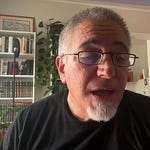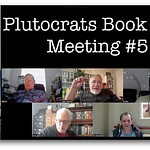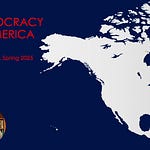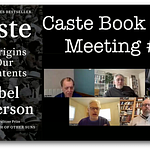After a bit of a delay, here’s my review of the second chapter of the US History course produced a couple of decades ago for the Great Courses series. If you’d prefer to read instead of watching, the notes I used are below:
Charles (Hapsburgh) had "much to gain from the grim reaper", according to professor Guelzo. The King of Spain. and Holy Roman Emperor, he continues, was the grandson of Ferdinand and Isabella. Then he says, "Christopher Columbus's royal patrons had only one child, Joanna, and she married into the most powerful ruling dynasty in Europe." It's true that Joanna did marry "Philip the Handsome", the Duke of Burgundy who became King of Castile briefly in 1506. But Joanna's sister Catherine married Arthur, Prince of Wales, and then when he died, his younger brother Henry (VIII). Ferdinand and Isabella's other surviving children were Isabella, who married Afonso, the Prince of Portugal; John, the Prince of Asturias; Maria, who married King Manuel I of Portugal. He goes on to say that Joanna only had one child also, Charles. This is also false. Joanna's children were Eleanor, Queen of Portugal and France; Isabella, Queen of Denmark; Ferdinand I, Holy Roman Emperor after the death of Charles; Mary, Queen of Hungary; and Catherine, who was also Queen or Portugal. Kind of a shaky start to this Great Courses lecture. The pompous-sounding voice he uses while reciting these errors doesn't help (although that may just be me).
Guelzo does mention that Charles had a big problem with Martin Luther and the Protestant challenge to the Vatican. He also suggests that Charles was annoyed by the pretensions of commoners such as Cortés and Pizarro, and moved rapidly to demote them and take control of the territories they had conquered in America. The Spanish Crown did consolidate these regions into the Viceroyalties of New Spain and Peru, but the Spanish had a long tradition of hidalgo low-born gentlemen, who had ennobled themselves by military success. So I doubt the way he characterizes the motivations.
Guelzo says that only 250,000 Spaniards came to the New World in the 1500s. This is a contextless number, though; he doesn't compare it to anyone else's colonization efforts. One thing about the Spanish conquest, of course, is that the majority of these immigrants were young men who took native wives or concubines and rapidly increased the population of *mestizo* people who had a higher social status than the natives (or later, Africans). These Spanish settlers founded hundreds of towns, Guelzo says, which is true. The repartimiento that followed the end of the encomienda gave Spaniards authority over native communities and a claim on their labor. He also mentions that one of the main achievements during this period was the extraction of 200 tons of gold and 16,000 tons of silver, which provided 3x to 5x the entire previous stock of precious metals in Europe.
The professor then briefly explains the encomienda, which he calls the encomendero and seems to confuse with the later repartimiento. He doesn't mention the supposed spiritual responsibilities of encomenderos to christianize the natives, but instead jumps right to how the church destroyed native books and culture (which is true). To his credit, Guelzo reiterates that it was really the European diseases that did in native cultures, although he regrettably adds "the self-inflicted disease of alcoholism", which is a bit too blatantly racist and in any case inaccurate for the period of Spanish conquest he's discussing.
Guelzo jumps to North America and says the east coast native population also was devastated by diseases, primarily by a series of contacts with Europeans. This is true, but another major spreader of disease among the Indians were the extensive trade and communication networks that existed in the native world. He lists a number of recorded outbreaks: smallpox in 1519 and typhus in 1531 and 1585, although he says these were only the largest and most visible. Another of course would be the result of De Soto's travels in the Southeast from 1539-42, which seems to have triggered a largely invisible population disaster among the southern remnants of the Mississippian culture. To his credit, the professor does describe this episode.
He then tells the story of Cabeza de Vaca's and Esteban's travels as slaves and then healers in the Southwest. Spain, he concludes, could "no longer afford" the freebooters. The wealth was "too much of a good thing" that poisoned the Spanish economy. He talks about military adventurism in the Netherlands and 500% inflation. By the mid-1600s, he says, Spain had spent its wealth and lost its influence. This mostly benefited France, he says. Under Henry IV, religious civil wars ended and Samuel de Champlain established Quebec and New France in 1608.
The French traded with natives for furs along the Saint Lawrence. He briefly describes the Iroquois/Huron rivalry and Champlain's intervention on the Huron's behalf. Iroquois enmity, he says, pushed the French westward rather than south, all the way to the Mississippi River, which LaSalle floated down and claimed Louisiana at its mouth. Guelzo blames Louis XIV's European adventurism for the lack of focus on America. And the French "cut off their nose to spite their face" by banning Huguenot emigration to America. The Protestant Dutch, on the other hand, hired Henry Hudson to find the Northwest Passage to the Pacific. What they got was fur trade with the Iroquois, the enemies of the Hurons and French. And because the Dutch put profit over religion, their colony became a cosmopolitan center where a visitor claimed 18 languages could be heard on the streets.













Share this post